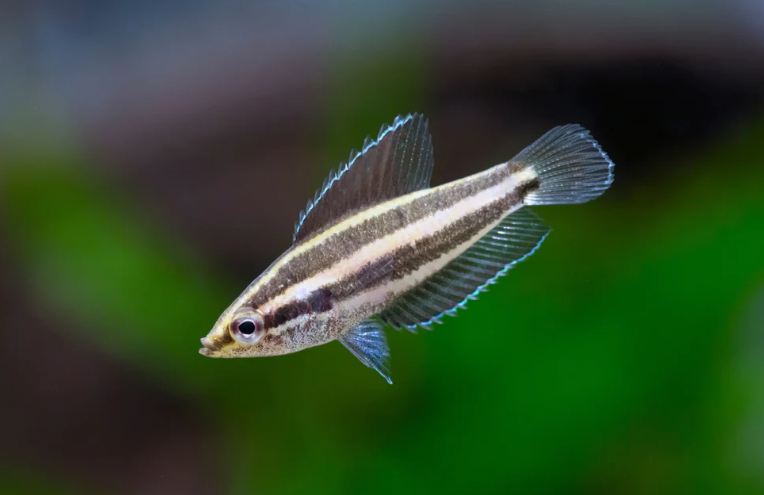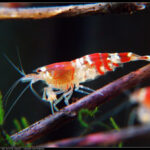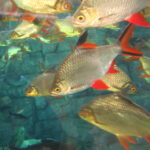The licorice gourami is a peaceful and shy freshwater fish species that belongs to the Macropodusinae subfamily of gouramis. It is endemic to Bangka, Indonesia, where it inhabits slow-flowing streams with black waters in peat swamp forests.
Aquarists are drawn to this species for its captivating appearance and mild temperament, making it suitable to be kept with its own species or similar-sized fish. Licorice gouramis require a specific tank size and water parameters to thrive, and they have a specialized diet.
Overall, they make for an interesting and low-maintenance addition to a freshwater aquarium.

Table of Contents
Overview Of Licorice Gourami
The Licorice Gourami is a captivating and peaceful fish belonging to the family Osphronemidae. It is popular among aquarists due to its small size and mild temperament, making it suitable to be kept with other similar-sized fish. It originates from Bangka, Indonesia, and is found in slow-flowing streams with blackwaters.
Introduction To Licorice Gourami As A Freshwater Ray-Finned Fish:
The Licorice Gourami, scientifically known as Parosphromenus deissneri, is a fascinating species of freshwater ray-finned fish. This captivating fish belongs to the subfamily Macropodusinae, which is part of the gourami family Osphronemidae. The Licorice Gourami is native to Bangka, an island located in Indonesia.
It is mainly found in slow-flowing streams with black waters that are associated with peat swamp forests. With its unique habitat and captivating appearance, the Licorice Gourami is a popular choice among fish enthusiasts looking to add diversity to their aquariums.
Endemic To Bangka In Indonesia:
One of the most interesting aspects of the Licorice Gourami is its restricted range. This fish is endemic to Bangka, which means it is found nowhere else in the world. Bangka, an Indonesian island known for its rich biodiversity, offers the Licorice Gourami its natural habitat.
Being endemic to a specific region adds to the allure of this fish, making it a sought-after addition to aquariums.
Found In Slow-Flowing Streams With Black Waters:
The Licorice Gourami’s preferred habitat consists of slow-flowing streams with black waters. These streams are usually associated with peat swamp forests, which provide the perfect conditions for the fish to thrive. The dark black color of the water is a result of the tannins released by decaying organic matter in the peat swamps.
This natural habitat not only creates a striking visual appeal but also influences the behavior and adaptations of the Licorice Gourami.
The Licorice Gourami is an enchanting freshwater ray-finned fish that is endemic to Bangka, Indonesia. It is found in slow-flowing streams with black waters, which are typically associated with peat swamp forests. The unique habitat and beautiful appearance of the Licorice Gourami make it a highly sought-after species among fish enthusiasts.
If you’re looking to add diversity and natural beauty to your aquarium, the Licorice Gourami is an excellent choice.
Care And Species Profile Of Licorice Gourami
The licorice gourami, a freshwater fish found in Indonesia, is a popular choice among aquarists due to its unique characteristics. This peaceful and shy species is best kept with its own kind or other similarly-sized fish with a mild temperament.
Importance Of Licorice Gourami Among Aquarists:
- Licorice Gourami is highly valued among aquarists due to its unique and striking appearance.
- It is considered one of the most beautiful and captivating species of fish that can enhance the aesthetic appeal of any freshwater aquarium.
- Aquarists are drawn to its vibrant colors, intricate patterns, and flowing fins, making it a centerpiece in their tanks.
- Licorice Gourami also attracts attention with its interesting behavior and interaction with other tank mates.
- Its peaceful nature and compatibility with various species make it a popular choice for community aquariums.
Belongs To The Osphronemidae Family Of Fish:
- Licorice Gourami, scientifically known as Parosphromenus deissneri, belongs to the Osphronemidae family, also known as the gouramis.
- This family comprises diverse species of freshwater fish known for their vibrant colors, unique patterns, and labyrinth organs, which help them breathe oxygen from the air.
- Members of the Osphronemidae family are often sought after by aquarists for their beauty, interesting behavior, and ease of care.
Popular Choices For Freshwater Aquariums:
- Licorice Gourami is a highly favored choice among aquarists for freshwater aquariums.
- Its striking appearance and peaceful temperament make it an ideal addition to community tanks.
- The small size of Licorice Gourami allows for easy accommodation in various tank sizes, making it suitable for both beginner and experienced aquarists.
- Its compatibility with other species also adds to its popularity, as it can peacefully coexist with a wide range of tank mates.
- Moreover, the adaptability of Licorice Gourami to various water conditions and its low maintenance requirements make it an excellent choice for aquarists of all levels of expertise.
Characteristics And Behavior Of Licorice Gourami:
- Licorice Gourami is known for its small size, reaching an adult length of around 2-3 inches.
- These fish have elongated bodies with vibrant colors, including shades of orange, red, yellow, and black, along with intricate patterns.
- They also have flowing fins, which add to their beauty and elegance.
- Licorice Gouramis are generally shy and peaceful, preferring slow-flowing streams and blackwater habitats in their natural environment.
- They are best kept in a well-planted aquarium with plenty of hiding spaces, as they appreciate having areas to retreat to.
- Providing soft, acidic water conditions and a temperature range of 24-28°C is ideal for their health and well-being.
- Licorice Gouramis are predominantly insectivores, feeding on small insects, mosquito larvae, and other tiny aquatic organisms.
- Taking care of Licorice Gouramis involves providing them with a balanced diet and maintaining suitable water parameters to mimic their natural habitat.
Licorice Gourami is a highly sought-after species among aquarists due to its captivating appearance, peaceful nature, and compatibility with various tank mates. Belonging to the Osphronemidae family, Licorice Gouramis are popular choices for freshwater aquariums, bringing color and beauty to any tank.
Understanding their characteristics and behavior is crucial for their proper care and ensuring their well-being in the aquarium.
Tank Setup And Care For Licorice Gourami
The Licorice Gourami, a peaceful and shy freshwater fish, is best kept with its own species or other similarly-sized fish with a mild temperament. It is popular among aquarists for its captivating nature.
The Ideal Tank Size For Licorice Gourami:
- Licorice Gourami requires a tank with a minimum size of 20 gallons to provide ample swimming space.
- A larger tank, such as a 30-gallon or 40-gallon tank, is even better as it allows for optimal swimming and provides additional territory for the fish.
Suitable Water Parameters (Temperature, Ph, Etc.):
- Licorice Gourami thrives in slightly acidic water with a pH range of 6.0 to 7.0.
- The temperature of the water should be maintained between 76°F and 82°F (24°C to 28°C) to mimic their natural habitat.
- Additionally, the water should be soft to moderately hard, with a dH range of 5 to 12.
Compatibility With Other Fish Species:
- Licorice Gourami is a peaceful fish that can be housed with other peaceful species in a community tank.
- Avoid aggressive or territorial fish that can harm or stress out the Licorice Gourami.
- Suitable tank mates include small tetras, rasboras, guppies, dwarf corydoras, and other peaceful gouramis.
Tips For Creating A Suitable Habitat For Licorice Gourami:
- Provide a well-planted tank with lots of hiding spots using live or artificial plants.
- Floating plants such as Water Sprite or Indian Fern will provide cover and create shade for the Licorice Gourami.
- Use a darker substrate, such as black gravel or sand, to replicate their natural habitat.
- Maintain good water quality by performing regular water changes and keeping the tank clean.
- Ensure proper filtration to keep the water parameters stable and remove any accumulated waste.
- Avoid bright lighting, as Licorice Gourami prefers dimly lit tanks.
- Include driftwood or bogwood in the tank as it releases beneficial tannins and creates natural hiding spots.
- Offer a varied diet of high-quality flake, pellet, and frozen foods to meet their nutritional needs.
Remember to conduct thorough research and seek advice from experienced aquarists to provide the best care for your Licorice Gourami.
Breeding And Incubation Of Licorice Gourami
Learn all about breeding and incubation of the Licorice Gourami, a captivating and peaceful freshwater fish. Discover the ideal tank setup, water parameters, and other important considerations for successfully raising this species.
Overview Of The Breeding Behavior Of Licorice Gourami:
- The Licorice Gourami is known for its unique breeding behavior, making it an interesting species to keep in captivity.
- These fish are bubble nest builders and the male takes on the responsibility of creating the nest and guarding the eggs until they hatch.
- During the breeding season, the male Licorice Gourami becomes territorial and aggressive towards other males.
- To attract a female, the male creates impressive bubble nests on the surface of the water using bubbles and plant material.
Unique Reproductive Characteristics:
- Licorice Gouramis have an interesting reproductive strategy where the male wraps his body around the female during mating.
- This behavior is known as embracing and it is believed to help the male position the female correctly for fertilization.
- The male fertilizes the eggs externally by releasing sperm over the eggs as the female releases them.
- After fertilization, the male gathers the eggs into the bubble nest for protection.
Tips For Breeding Licorice Gourami In Captivity:
- Provide a separate breeding tank for the Licorice Gouramis with ample hiding places and plants for the bubble nest.
- Maintain a water temperature of around 78-82°F (26-28°C) and a pH level between 6.0-7.0 for optimal breeding conditions.
- Feed the breeding pair a nutritious diet consisting of live or frozen foods to enhance their reproductive health.
- Introduce the male and female into the breeding tank together and observe their behavior for signs of courtship and spawning.
- Once the eggs are laid, remove the female from the tank to prevent her from eating the eggs or disturbing the nest.
Incubation Period And Care For Fry:
- The incubation period for Licorice Gourami eggs is typically 2-3 days, depending on water temperature.
- The fry will hatch and begin swimming freely within a few days of hatching.
- During this time, it is important to provide a well-filtered and well-maintained tank to ensure the fry’s survival.
- Feed the fry small live or micro-sized foods like infusoria or newly hatched brine shrimp.
- As the fry grow, gradually introduce them to larger foods such as baby brine shrimp and crushed flakes.
Remember, breeding Licorice Gouramis requires patience and proper care. By providing the right conditions and monitoring their behavior, you can successfully breed and raise these fascinating fish in captivity.
Frequently Asked Questions On Licorice Gourami
Are Licorice Gourami Peaceful?
The Licorice Gourami is a peaceful fish that is best kept with its own species or similar-sized fish with a mild temperament.
Will Licorice Gourami Eat Shrimp?
Yes, licorice gourami will eat shrimp.
What Size Tank For Licorice Gourami?
The recommended tank size for licorice gourami is a minimum of 20 gallons.
Are Licorice Gourami Peaceful?
The Licorice Gourami is a small and peaceful fish that prefers to be kept with its own species or other similar-sized fish with a mild temperament.
Conclusion
The Licorice Gourami is an intriguing and captivating freshwater fish that is highly popular among aquarists. Its peaceful and shy nature makes it best suited for tanks with its own species or other similar-sized fish with a mild temperament. The Licorice Gourami is a member of the Osphronemidae family and is endemic to Bangka in Indonesia, where it is found in slow, flowing streams with black waters associated with peat swamp forests.
When it comes to care, the Licorice Gourami requires a moderate level of attention. The tank setup should be well-maintained with suitable water parameters, including a temperature range of 24-28°C. Adequate hiding spots, lighting, and plants should also be provided.
While they are not known to eat shrimp, caution should be exercised when mixing them with other species. Overall, the Licorice Gourami is a beautiful and fascinating addition to any freshwater aquarium. With proper care and attention, these stunning fish can thrive and bring joy to fishkeepers.
References
- Food and Agriculture Organization of the United Nations (FAO): https://www.fao.org/fishery/ – Provides global data and insights on freshwater aquaculture, including production statistics, species profiles, and sustainability frameworks.
- Network of Aquaculture Centres in Asia-Pacific (NACA): https://enaca.org/ – Focuses on sustainable aquaculture development in the Asia-Pacific region, with projects related to small-scale fish farming and breeding practices applicable to gouramis.
- WorldFish: https://simple.wikipedia.org/wiki/Fish – Conducts research and promotes responsible aquaculture practices in tropical countries, potentially involving topics like genetic improvement and disease management in gouramis.
- International Union for Conservation of Nature (IUCN): https://www.iucnredlist.org/ – Maintains the IUCN Red List of Threatened Species, which assesses the conservation status of numerous gourami species and provides valuable ecological data.
- Ornamental Aquatic Trade Association (OATA): https://ornamentalfish.org/ – Promotes responsible practices in the ornamental fish trade, including sourcing and welfare considerations for aquarium gouramis.
Please check other articles on this website, I have listed some of them here:
Electric Blue Acara: The Ultimate Guide To Care And Keeping
Best Fish for a 40 Gallon Tank: Top Choices for a Thriving Aquarium
Simple Guide to Easy-to-Care-for Aquarium Plants
Discover the Diverse Corydoras Catfish Varieties- A Guide
Get to Know Various Types of Algae Eaters
Master Guide: Best Water Parameters for Goldfish Care 2023-24
Mastering Black Ghost Knife Fish Care: A Comprehensive Guide
Optimal pH Levels for Tropical Fish: Essential Aquarium Guide
Discovering Freshwater Snail Species: An In-depth Guide
Expert Tips for Breeding Guppies: Keys to Successful Fishkeeping
Discover Peaceful Community Fish: Your Guide to Calm Aquatics
Ultimate Guide to Live Food for Betta Fish — Healthy Choices
Complete Guide to Your Perfect Cichlid Tank Setup
Your Guide to the Best Substrate for Planted Aquariums
Essential Guide to Discus Fish Care: Help Your Pets Thrive!
Grow Your Own Eden: Beginner-Friendly Aquascaping Plants Guide
Perfect Neon Tetra Tank Mates: Guide to Aquarium Harmony
Product Review of Eheim Classic vs Professional
The Ultimate Guide to Discus Fish Care
What Fish Can Live With Discus?
Ideal pH for Discus Fish | Aquarium Water Guide
How to Sex Discus Fish?: A Simple Guide for Hobbyists
Complete Discus Fish Tank Setup Guide
Can Discus Fish Live With Angelfish? The Complete Guide
Discus Diet Guide: What Do Discus Fish Eat?
Are Discus Fish Hard to Keep? Insights & Tips.
Optimal Discus Fish Water Parameters Guide
Discus Fish Size Guide 2024: How Big Do Discus Fish Get?
Ultimate Million Fish Guppy Care Guide 2024
Simple Guide to Easy-to-Care-for Aquarium Plants
Grow Your Own Eden: Beginner-Friendly Aquascaping Plants Guide
Hornwort Aquarium Plants: The Ultimate Guide to Care and Maintenance
Aquarium Equipment for Beginners: The Complete Checklist
Feeding Your Aquarium Fish: The Complete Guide
Common Beginner Fishkeeping Mistakes and How to Avoid Them!
Aquarium Plants for Beginners: Easy Care and Beautiful Options
Keeping Your Aquarium Water Clean and Healthy: The Complete Guide
Breeding Aquarium Fish: A Comprehensive Guide
Marine Aquariums: The Ultimate Challenge for Experienced Hobbyists
Tech in the Tank: Must-Have Gadgets for Aquarium Automation
Dwarf Sucking Catfish : The Ultimate Guide to Keeping and Caring for Oto Catfish
The Science of Aquarium Water Chemistry: Understanding pH, KH, and GH
Veiltail Goldfish: The Exquisite Beauty of Flowing Fins
Perfect Neon Tetra Tank Mates: Guide to Aquarium Harmony
Goldfish Care: Beyond the Bowl – Everything You Need to Know
Master Red Tail Shark Care: Tips, Tank Mates & Surprising Traits!
Sheepshead Wrasse Facts & Habitat Guide
Unveiling the Unique Asian Sheepshead Wrasse: A Fascinating Reef Fish with Quirky Behavior
Peacock Wrasse: A Dazzling Addition to Your Aquarium
Vibrant Wrasse Fish: Care Guide & Species Info
Bluestreak Cleaner Wrasse – Vibrant Reef Ally
Coris Wrasse Care Guide for Saltwater Aquariums
Melanurus Wrasse Care Guide & Habitat Tips
I am a passionate aquarist with over 30 years of hands-on experience in fishkeeping. My journey began at a young age, collecting fish from the wild and learning through experimentation. Specializing in tropical fish, I bring a deep understanding of the hobby to FishKeepingMadeSimple. The site provides honest, detailed reviews of essential products and accessories to help fellow enthusiasts create the best environments for their fish.













[…] we delve deeper into the world of egglayers, we will discover the wide range of species that employ this fascinating reproductive strategy. From tropical tetras to majestic angelfish, the diversity of egglaying fish […]
[…] Dragon Goby, also known as Amblygobius phalaena, is a fascinating species of fish found in saltwater environments. It is known for its distinctive physical appearance and […]